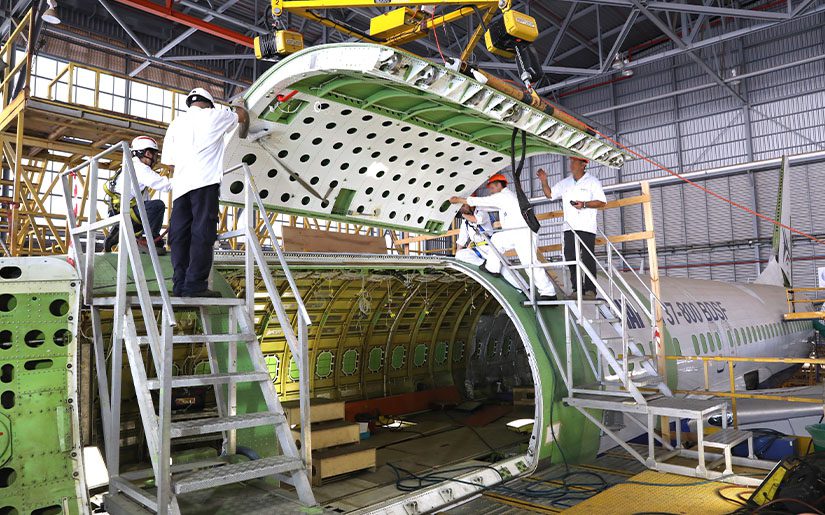
B737 800BDSF Passenger to Cargo Conversion 2 825x515
Lessor Aircastle is looking at converting four of its Boeing 737-800s and a couple of Airbus A330s into full freighters but it has no intention to return big-size to the freighter market, it said during its third-quarter FY21 results presentation on January 13.
Aircastle had a fleet of 264 managed and owned aircraft leased to 79 customers in 43 countries. Back in 2014, freighters and what it calls ‘classic aircraft’ accounted for 22 percent of its portfolio. Last November, its freighter fleet was just one percent, with ninety percent of its portfolio consisting of narrowbody passenger aircraft like the Boeing 737NG and MAX, Airbus A320ceo/neo-family, and Embraer E1/E2-jets. The remaining nine percent is widebodies.
Asked if Aircastle eyes to re-enter the booming freighter market, CEO Mike Inglese said: “A number of years ago, freighters were a much bigger percentage of our portfolio. Frankly, it didn’t work out as we had hoped. Given our own experience, we still see that there may be some opportunities in the passenger to freighter conversions. We will basically look at what we own today if there is an opportunity to maximize the value of an asset.”
Inglese said there are a few aircraft that are eligible for conversions: “We have some 737-800s that we wish to convert, but it is modest. It is four aircraft. There are reasonably near-term slots with Israel Aerospace Industries (IAI), so we think we will have a good outcome and are in discussions with a number of prospective lessees on those four aircraft. We are also looking at some opportunities for a few A330 conversions, but I emphasize a few. Again, it is asset-value maximization, it’s not really drifting into getting back and building freighter exposure in a big way for Aircastle.”
Net loss was driven mainly by Garuda impairment
The lessor, which was fully acquired by its previous shareholders Marubeni and Mizuho Leasing last March, reported a net loss for Q3 of $62.4 million compared to a $2.7 million profit in the same period last year. This was mainly due to an impairment of $45 million on three aircraft that are placed with Garuda Indonesia but that the airline will return as part of its restructuring plan.
Of it 79 customers, six are involved in judicial insolvency proceedings that have 21 aircraft on lease from Aircastle, representing thirteen percent of its book value. On January 7, the lessor’s total lease deferrals net of repayments were $87 million to nineteen airlines, with an average deferral period of six to twelve months. Of all deferrals, 87 percent were part of broader lease restructurings that include term extensions. Aircastle is confident that its financial position with $2.1 billion in liquidity and $4.6 billion in debt is strong enough to deal with these deferrals. The lessor also has $715 million in maintenance reserves and other deposits.
The lessor mentioned some ten aircraft in its portfolio that it wanted to place in its fourth quarter, but actually, it has already Letters of Intent for six of them, including three ex-South African A330s and the two Garuda 737-800s that already have been removed with the airline. Another aircraft will be parted out. For the coming FY22, Aircastle has sixteen leases expiring coming up, of which eight or nine will be parted out as well.
No plans for placing big orders
Last year, Aircastle delivered six A320neo’s (four to Frontier), one Boeing MAX 8, and the first three of fifteen Embraer E195-E2s to KLM Cityhopper. It has no intention to place direct orders soon. Mike Inglese said there are still plenty of young and used 737NGs and A320ceo-family aircraft that are looking for new homes. “There may be opportunities with the OEMs of which we are able to take advantage of, but people shouldn’t be expecting a big shift in is Aircastle going to place a big order with Boeing, Airbus, or anyone else at this point.”
Inglese doubts if the OEMs will be able to deliver on the production rate ramp-ups that they are announcing, with Airbus going to 65 neo’s from June 2023 and likely higher in 2024 and 2025, and Boeing looking for rate 31 this year and more after that. “They have a different business model than I do. Will they be able to ramp to where they say they will be going in the next two years? I dot many people who don’t work at Airbus and Boeing are believing that, giving what is going on in the world in the context of the supply chain.”
Views: 2



